 |
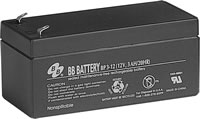 |
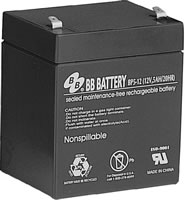 |
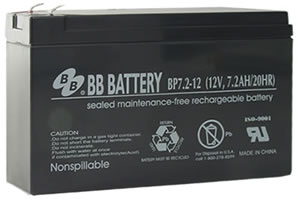 |
| 2.3AH | 3.0AH | 5.0AH | 7.0AH |
| 7.01" x 1.34" x 2.36" | 5.28" x 2.64" x 2.36" | 3.54" x 2.76" x 4.02" | 5.94" x 2.54" x 3.66" |
| 2.2# | 3.0# | 4.06# | 5.85# |
| $9.97 | $10.37 | 10.57 | $13.87 |
There are two kinds of batteries to use, sealed lead acid (SLA) and Nickel Metal Hydride (NiMH). Sealed lead acid are less expensive and the chargers cost much less. NiMH have a better weight to capacity ratio. NiMH batteries, especially AA cells, have plunged in price recently. There is no point in considering NiCad batteries as they are at price parity with NiMH batteries. NiMH batteries pack more energy in a cell than NiCads, and they do not suffer from the so-called "Memory Effect" (this effect is actually very real but it should be called "voltage depression," see page 40 of The Video Battery Handbook for details). Personally I have no problem with sealed lead-acid batteries for commuting. My 5AH sealed lead-acid battery will run my lights (30 watts), for about 1:40 (measured), which is more than twice the time I need.
Maximum Current Draw
Calculate the current draw of your lamps (Amps=Watts/Volts). Try not to exceed
70% of the batteries AH rating per hour. I.e., on a 5AH battery, try to keep the
current draw at or below 3.5A (42 watts of lamps @ 12 volts). For a 10 pack of
2000mAH AA cells (2AH), try to keep the current draw down to 1.4A (16W of lamps
@ 12 volts). On my 30W system, using a ten pack of 2000mAH NiMH AA cells did not
really work. The current draw was 2.5A, 125% of the AH ratting of the battery.
The batteries were unable to supply that much current so the lamps were not at
full brightness (and the batteries got very hot). However if I turned on only
one of the headlamps the NiMH batteries were fine. To use NiMH cells with 30
watts of lamps I would have to use two packs of AA cells in parallel, or use C
or D cells.
Minimum Battery Sizes Based on Total Watts of Lamps
| Head Lamps (W) |
Tail Lamps (W) |
Total (W) | Current Draw (A) |
Minimum 12V Battery (AH) |
Minimum 12V Battery (WH) |
| 10 | 2 | 12 | 1 | 1.5 | 14 |
| 14 | 2 | 16 | 1.3 | 2 | 24 |
| 15 | 2 | 17 | 1.4 | 2.1 | 25 |
| 20 | 2 | 22 | 1.8 | 2.75 | 33 |
| 25 | 2 | 27 | 2.2 | 3.3 | 40 |
| 28 | 2 | 30 | 2.5 | 3.75 | 45 |
| 30 | 2 | 32 | 2.7 | 4.2 | 50 |
| 35 | 2 | 37 | 3.1 | 4.6 | 55 |
Sealed Lead
Acid
For 12 volt systems, sealed lead
acid batteries are less expensive than NiMH batteries, especially due to the
fact that a smart NiMH charger costs $45-85, while a smart sealed-lead acid
charger can be purchased for as little as $14. The downside to sealed lead-acid
batteries is that they are heavier in terms of weight/Watt-Hour. Sealed
lead-acid batteries are rated at 20 hour discharge rates and faster discharge
rates (as will be the case with bicycle lights) mean that the actual watt-hours
you get will be less than the rating. The sealed lead-acid chargers are cheap
enough that you could keep one at work and one at home.
The best selection of sealed lead-acid batteries and chargers, at the best prices are at zbattery.com. Keep your sealed lead-acid batteries charged during long periods of non-usage or they will go bad. Do not buy old or used sealed lead-acid batteries. "Removed from equipment" means that the battery is either used or has sat around for a long time. I bought three SLA batteries from American Science and Surplus and all were bad.
Sealed Lead Acid Batteries
 |
 |
 |
 |
| 2.3AH | 3.0AH | 5.0AH | 7.0AH |
| 7.01" x 1.34" x 2.36" | 5.28" x 2.64" x 2.36" | 3.54" x 2.76" x 4.02" | 5.94" x 2.54" x 3.66" |
| 2.2# | 3.0# | 4.06# | 5.85# |
| $9.97 | $10.37 | 10.57 | $13.87 |
NiMH
(Nickel Metal Hydride)
You can use ten NiMH batteries (AA, C, or D) if you want to spend the extra
money. A ten cell AA battery holder is available from Minute-Man
Electronics, and is also available from Thomas-Distributing.
Watch out for the thin
wires usually used on AA battery holders as they may not be sufficient for high
drain batteries. Conventional alkaline cells are not capable of high discharge
rates and these battery holders are usually designed for low current drain.
For AA NiMH batteries, do a www.froogle.com search for "LENMAR PRO-1020." I have seen these ten packs of 2000mAH AA cells available for less than $10. However the best source, including shipping, appears to be K&B Electronics whose price is $10.79; many of the lower priced retailers have very high shipping charges. Efunctional.com has a lower price than K&B, but unless you're ordering several packs then the higher shipping offsets the lower price. If you live near a Fry's Electronics, watch for their sale on Lenmar 2000 mAH batteries, usually one 4-pack for $5. Fry's sells the Lenmar ten pack for $18, not on sale. It used to be that it was better to order NiMH batteries from places like Thomas-Distributing, but now that AA cells have become a commodity item you can find them more cheaply at other outlets. Costco sells a bundle of a Panasonic charger, six Panasonic 2100 AA cells, and two Panasonic AAA cells, for $20, the six AA batteries would be sufficient for a 10W system. Micro-Center sells 4 packs of Sakar iConcepts 2000mAH AA NiMH batteries for $4.94, I don't know the actual capacity of these batteries.
While NiMH batteries can have relatively high discharge rates, it is best to keep the rate at 70% or less than the battery capacity. I.e. a 2000 mAH cell will work longest if the discharge current is under 1.3A. Ten 1.2V 2000mAH batteries will provide 24WH, so try to keep the wattage of the lights less than or equal to 16 watts. Discharge rates of greater than 1.3 amps are not advised as the internal resistance of the batteries is too high for such a high discharge rate. I tried 30W (two 14W headlamps and one 2W tail lamp) on ten NiMH AA cells, and could see that the headlights dim when both headlamps are turned on (plus the batteries get very hot).
NiMH Batteries
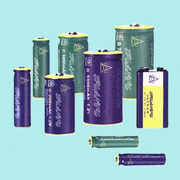 |
 |
 |
|
| PRO1020 NoMEM PRO | C size, button top | D size, button top | D size, button top |
| AA | C | D | D |
| 2000 mAH | 4500 mAH | 7500 mAH | 9000 mAH |
| $8.73 $10.79 | $4.50 each | 2/$11.99 | $7.50 each |
Over-Voltaging with NiMH batteries
You can use eleven cells (13.2V) or twelve
cells (14.4V) for extra brightness and duration with drastically reduced bulb life.
The only charger than can go up to 14.4V is the MH-C777PLUS, but the other Maha
charger I listed will do 13.2V packs. The trick of slightly over-voltaging a
bulb in order to increase brightness and duration is used by some of the
commercial bicycle lighting companies. Use two six-AA battery holders instead of
a single ten AA battery holder, if you're going to over-voltage to 14.4V. Use
one ten-AA battery holder and one one-AA battery holder if you're going to
over-voltage to 13.2V.
The big advantage in over-voltaging is that you get disproportionately more brightness for the increase in power consumption. The big disadvantage in over-voltaging is that bulb life is disproportionately reduced.
You can see a graph of light output versus power versus bulb life at: http://www.myra-simon.com/bike/lights.html#overvolting. Over-voltaging by 10% (13.2V) increases power consumption by about 18% and decreases bulb life by about 74%, but it increases light output by about 39%. Over-voltaging by 20% (14.4V) increases power consumption by about 24% and decreases bulb life by about 88%,but it increases light output by about 83%. So a 2000 hour lamp will last about 500 hours if over-voltaged by 10%, about 250 hours if over-voltaged by 20%. Even so, bulbs are cheap, and 250 hours could equal a year of commuting. There are long life (10,000 hour) MR16 lamps, but not in the lower wattages used for bicycle lighting. Carrying an extra bulb is a good idea even when you're not over-voltaging. In short, over-voltaging is a very good idea as long as you are willing to accept the consequence of more frequent bulb changes.
Parallel NiMH Battery Packs for Longer Duration
For longer duration, and/or higher current capacity, use higher mAH batteries, or use multiple battery packs.
While higher mAH cells (i.e. C cells or D cells) are technically a better
solution, the advantage of using AA cells is that they are very inexpensive (C
& D cells have not come down in price nearly as much). One
good thing about NiMH battery packs is that you can connect them in parallel (same
voltage). You can connect two 12-14.4 volt packs together and double your
duration. Each pack must have the same number of cells and you should use the same
type of cells (same capacity) from the same manufacturer in each pack. Both packs should be fully charged when connecting them together. You do not
need any isolation between the packs. There is one caveat:
YOU CANNOT CHARGE PARALLEL-CONNECTED NiMH PACKS--YOU MUST CHARGE EACH PACK SEPARATELY!
Is that clear? Separate the two packs and charge each pack on its own.
Serial Battery Packs for Longer Duration
You can always carry extra battery packs and simply install a fresh pack when the first pack is exhausted.
NiMH Battery mAH Ratings
Every brand of NiMH batteries is different. A 2000mAH cell will have real
mAH rating from 1754mAH to 1856mAH (according to an independent test). You can see
ratings of various NiMH AA cells at: http://www.imaging-resource.com/ACCS/BATTS/BATTS.HTM.
Perform a cost/mAH analysis on the various batteries. For example, the Lenmar 1754mAH AA
cells cost about $0.90 each, while the Powerex 1856mAH AA cells cost $3.50 each; nearly
4X the price for less than a 6% increase in capacity (and in the duration test
there was less than a 3% difference).
|
|
Return to Table of Contents |
|
e-mail webmaster |
|
Wide-Mouth
Water Bottle
This
method is used by many of the commercial lighting system manufacturers; they
like it because it is very inexpensive, does not require clamping or strapping
the battery to the frame, and is easily removable, which many commuters require.
I hate it because I want my water bottle cage free for a water bottle. You may
need to formulate the battery pack to fit the bottle, which may mean buying
batteries with solder tabs and arranging them in a cylinder pattern (this is
more expensive than buying standard AA cells, but not significantly more). The wires come out through
the nipple. You could also put the switches through the side of the bottle. Of
course you lose the use of the water bottle cage for a real water bottle or
coffee bottle. Not to worry, there are many ways of adding another bottle cage,
see my web site Adding
Water Bottle Cages to Bicycles without Braze-Ons for details.
A water bottle (or coffee bottle) belongs in your water
bottle holder, not a jacket, bottle of air, cell phone, tools, lock, or batteries.
It is quite annoying how
so many accessory manufacturers think that
the water bottle cage is fair game as way for them to get around providing their own
mounting hardware. I don't want to give up my water bottle cage for a battery, cell phone, tools,
compressed air, jacket, etc. Your mileage may vary, but what are you going to do when you're thirsty or
hot, drink batteries or tools? While in the past, road bikes and touring bikes
usually came with two or three sets of braze-ons for cages, this is normally not
the case any more, in fact on some compact frame "women's" bicycles,
the single set of water bottle cage braze-ons isn't even usable without a
special rotating bottle cage (see below); my wife bought a Specialized
Expedition and got the "man's" model, solely because of the water
bottle issue, but few people would even have realized the problem at the time of
purchase, and even fewer would have been aware of the workaround.
Many
different accessories compete for your water bottle cage
(Click
Images for Details)
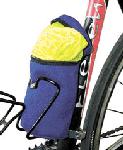 |
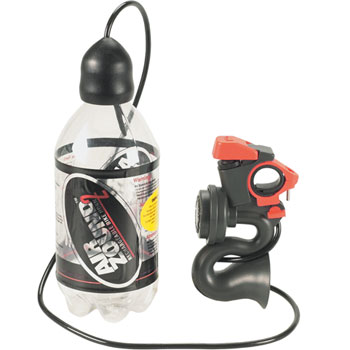 |
|
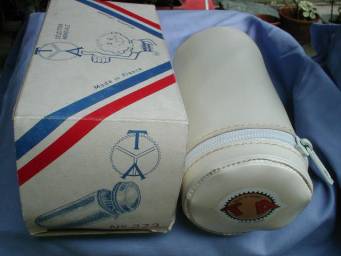 |
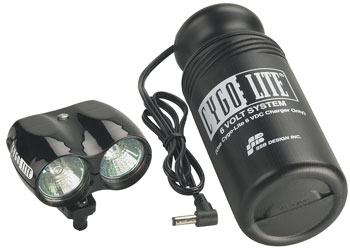 |
 |
 |
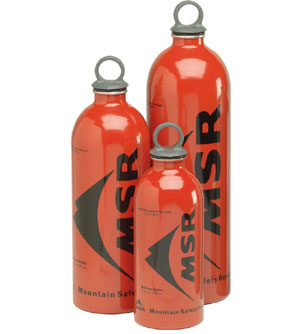 |
|
|
Jacket
Bag
Use Profile Cage for best fit |
Airzound
II
Use Profile Cage for best fit |
Cell
Safe DX4 Use Profile Cage for best fit |
Tool
Bag
Use Profile Cage for best fit |
29pc Water Bottle Bicycle Tool Set | Master Lock Street Cuff Bracket |
Fuel
Bottles (for bicycle camping)
Use Profile Cage for best fit |
This cyclist, cooling off on a Sonoma County trail, is glad to have a water bottle rather than a bottle of tools or batteries! Unfortunately, this is not a common sight! |
The profile cage is preferred for many water bottle cage-mount accessories because it grips the bottom of the bottle only. Many water bottle type accessories don't have the indentation for the angled section of a metal cage to go into.
Click Image for Details
A solution for bicycle frames
where a normal water bottle cage is not usable
Click
Images for Details
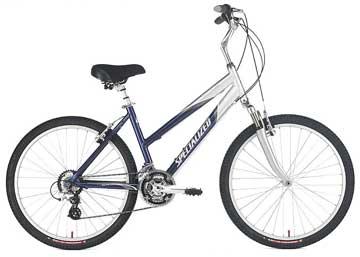 |
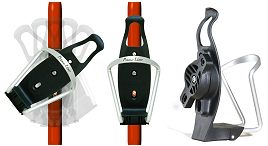 |
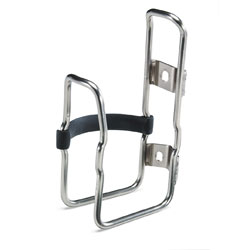 |
| This "women's" frame bicycle has a useless set of water bottle braze-ons unless you buy one of the new rotating bottle cages (the braze-ons are right above the "S" and the "E" in "Specialized" on the lower down tube). | This unique bottle cage solves the problem of being able to use a water bottle on some "women's" bicycle frames. $16. | This cage from Specialized solves the problem of being able to use a water bottle on smaller frame bicycles. $10. |
Frame Bag, Seat Bag,
Rack-Top Bag
The
battery or battery pack is placed inside a frame bag or seat bag. Use a rack-top
bag that attaches securely with buckle type fasteners, not Velcro. Not only
because the battery is heavy, but because the Velcro type of attachment doesn't
retain its strength over years or removal and attachment.
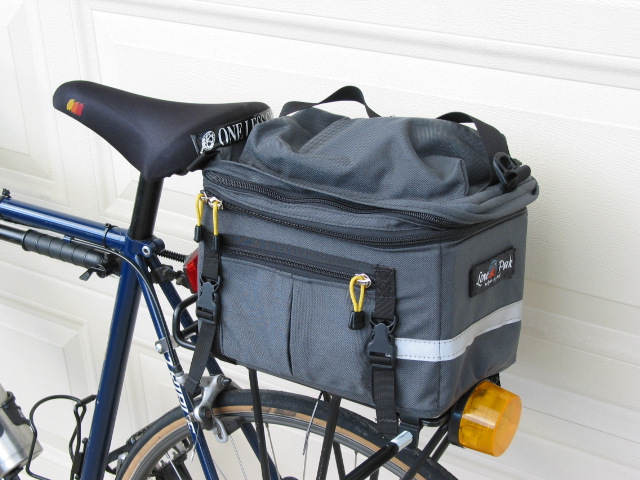 |
|
The Lone Peak RP-700 attaches with buckles, not Velcro. I went through two poor quality rack packs before spending the big bucks on a higher quality product with superior design features. I'll let you know in five years how it holds up! Alas, my opinion of Lone Peak has been tempered by a recent experience. One of the straps on my wife's RP-700 fell off, and I sent the pack back to Lone Peak, expecting it to be fixed for free under their lifetime warranty. Instead, they claimed that the pack had been abused, and charged me for the repair, and the return shipping. It wasn't a lot of money, but it was petty of them to charge me, and it was annoying for them to claim that somehow the strap falling off was my fault. |
Plastic Case
The battery or battery pack
is placed inside a plastic case which is attached to the frame with
some sort of clamp, i.e. the Zefal Gizmo Clamps, padded U bolts, etc. This is
more permanent mount which is less likely to be stolen if left on the bike. You
could put the switches through the side of the box as well, eliminating the
handlebar controls. This approach makes battery changes more difficult as you'll
have to remove the lid of the case, so it's not a good approach if the duration
of your commute requires battery swaps (though you could put multiple battery
packs inside and have SPDT switch to select between the two (while it is fine to
connect two battery packs in parallel for running the lights (no isolation is
needed), it is NOT fine to charge two packs in parallel, so a switch is
necessary)). It also requires
that the charger be located close to the bicycle.
Inside Seat Tube
I've
never tried this, but AA cells will fit inside a seat tube. You'll need to buy
solder-tab type batteries, make a ten pack, seal the pack inside heat shrink
tubing with wires coming out through the seat post. You may want to use some
foam to prevent rattling. If the top of the seat post is sealed then you'll need
to drill a hole for the wires.
Images for Details
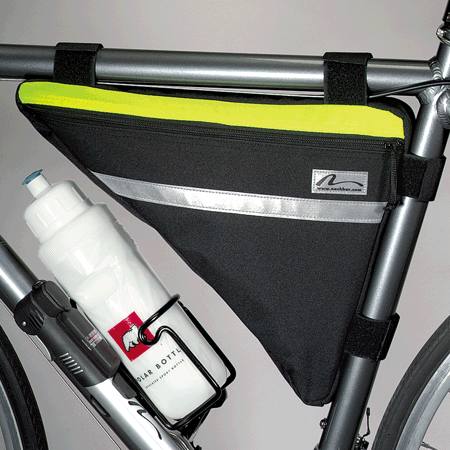 |
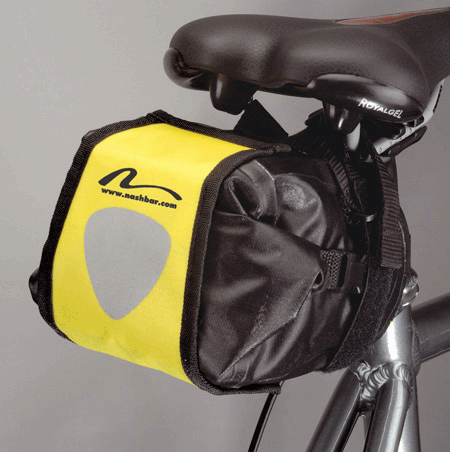 |
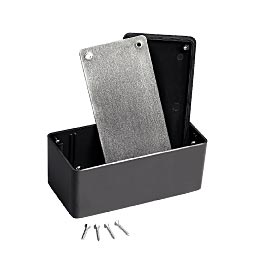 |
|
| Frame Bag | Seat Bag | Wide Mouth Water Bottle | Plastic
Enclosure 6"x4"x2" 270-1806 Big enough for two AA battery packs (smaller enclosures available) |
| $3 | $6 | $5 | $5 |